Which San Diego newspaperman did John Glenn get to spike the astronaut sex story?
John Glen #JohnGlen

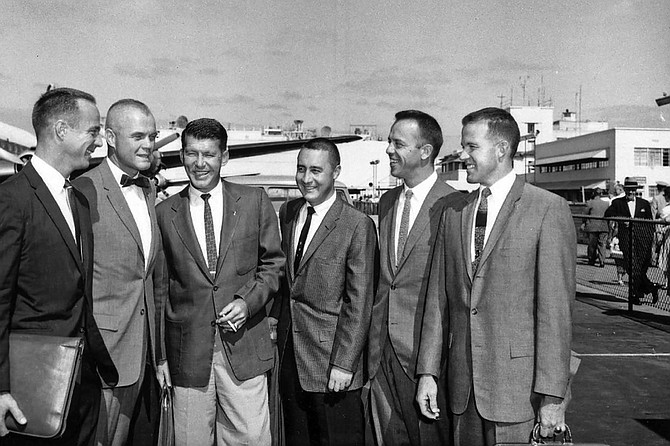
Photograph courtesy San Diego Air and Space Museum Archives
Astronauts arrived at the old Lindbergh Field Pacific Highway terminal on September 19, 1959.
On September 19,1959, six of America’s first spacemen settled in at the Kona Kai Club on San Diego’s palm-bedecked Shelter Island for a week designed to feature the Atlas rocket that would blast their Mercury capsule into orbit. Their days involved technical seminars and motivational talks at the vast Convair-Astronautics missile factory in Kearny Mesa. Nights included hosted dinners and community receptions. Local media promoted what one editorial called “the glow of patriotic pride” and showed them water-skiing at Mission Bay and skin-diving at La Jolla Cove.
Even mishaps received positive spin. During the visit, an Atlas exploded while undergoing a static test firing — but the article about the event stressed the astronauts’ full confidence; their dismay was only over the “money that went down the drain.” At week’s end, they held a press conference for student editors of high school papers to stimulate teenage interest in space. The overall coverage was the most extensive anywhere to date, apart from Life magazine’s exclusive pieces on their families and lifestyles.
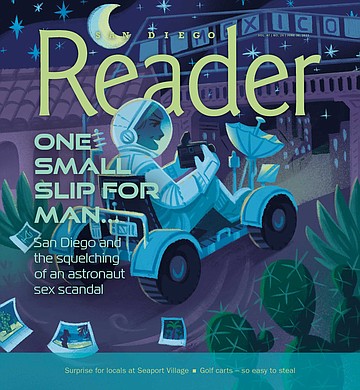
Illustration by Audrey Isaacson
But while the coverage was extensive, it wasn’t exhaustive. Amidst the upbeat atmospherics, a sordid Tijuana sexual escapade that could have cratered the astronauts’ wholesome image stayed secret — the result of connivance between a newspaper and future space hero John Glenn, who in 1962 became the first American to orbit the earth. Six decades later, both the paper and journalists involved remain unidentified, and an accounting of the newspaper’s role has never surfaced, even as other major pieces of the story have slowly emerged through histories, biographies, and memoirs of the space program’s first years.
It took 20 years before even the first elements spilled. Tom Wolfe, in his 1979 best-selling book The Right Stuff, laid bare the Mercury Seven’s complicated mix of jealousy, camaraderie, philandering, and patriotism behind the facade that Life had concocted (with the wholehearted support of space officials). Wolfe described a half-year of tension since their April 1959 selection over the ease of extramarital sex owing to their elite military flyboy status. That tension came to a boil inside a Kona Kai suite in one of their periodic group-only meetings — gatherings informally known as “seances” — that were usually concerned with technical matters. But in San Diego, Glenn and Alan Shepard, later to become the two most famous of the original seven, squared off in front of their colleagues over the issue of skirt-chasing.
The squeaky-clean Glenn lit into those who were incessantly playing around, warning that, like it or not, they were now public figures, and that a national scandal about infidelity would seriously derail the nascent program. Shepard, who from every historical account despised the media, hit back hard, arguing that what they did with their little free time — set aside after rigorous physical training, travel, and technical study — was their own business. Wolfe wrote that a majority agreed philosophically with Shepard, and sided only grudgingly with Glenn in conceding that, at least for the near-term, the astronauts should dial back the off-duty debauchery. (Life’s cover story that week gushed over the spacemen’s loyal wives.)
Four years later, Glenn revealed the week’s more explosive aspects that precipitated the contretemps in Glenn: the Astronaut Who Would Be President, the 1983 biography by Frank Van Riper. And Glenn repeated the details in his 1999 John Glenn A Memoir, co-written with Nick Tayor. According to Glenn:
He was awakened at 2 am by a call from Air Force Lt. Col. John “Shorty” Powers, spokesman for the group, lamenting that what both Powers and Glenn had feared for months was coming to pass. A reporter had phoned Powers before midnight to say that he had followed an astronaut the previous night across the border, that the paper had compromising photos of him with a woman in Tijuana, and that a story was running in the morning. Powers, who had no media background and was a heavy drinker, had stewed over the information and then contacted Glenn to share his gloom.
Glenn summoned Powers to his room. And, despite the predawn hour and despondent attitude of Powers, Glenn proceeded to call both the reporter and the photographer, and ultimately reached the newspaper’s publisher to argue that “the Russians, godless Communists” were beating America into space, and that the story could kill the country’s chances of getting back into the race with the Soviet Union. “I pulled out all the stops,” recalled Glenn. He then went back to bed, unsure if his full-court press had worked.
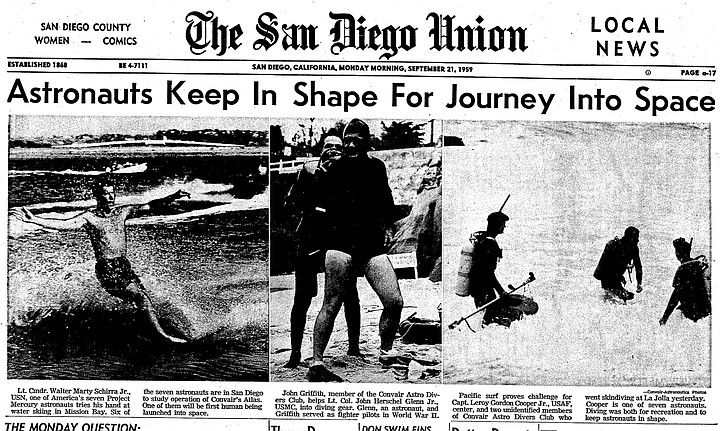
San Diego Union newspaper story from September 21, 1959.
When the alarm clock rang, Glenn hustled to the Kona Kai lobby newsstand and sighed with relief when he found that the morning paper had no story about the incident. “But it well could have if I hadn’t talked to them,” he told Van Riper in 1983, and in 1999, he added in his memoir, “To this day, and knowing the press much better now, I’m still amazed that it didn’t run.” It was later that morning that Glenn called for the astronauts-only meeting in which he and Shepard faced off. (Shepard was identified as the Tijuana astronaut only posthumously, in Neal Thompson’s 2004 biography Light this Candle.)
Over the 63-year span since the week at Kona Kai, Glenn’s two recountings remain the sole source for information about the newspaper incident in every book that repeats the story. In 23 oral histories conducted with him between 1996 and 2009 at Ohio State University, the interviewers never asked about the Kona Kai week. Glenn died in 2016, having never publicly disclosed the identity of the journalists or the newspaper, other than to say it was a “leading West Coast” daily. If he privately gave those details to the five other astronauts at the Kona Kai, none ever repeated it for the record. Neither Glenn nor his compatriots ever publicly tagged Shepard, despite the suspicions of many, holding to their military code of silence on that score.
Spokesman Powers, who died in 1979 of chronic alcoholism at age 57, sat for an oral history with the University of Houston in 1968, a decade before The Right Stuff recast the Mercury Seven’s image, and was not asked about (nor did he volunteer) any of the astronauts’ peccadilloes. Shepard, in the 1994 book Moonshot, which he co-authored with Mercury colleague Deke Slayton, referred to the San Diego events only indirectly, citing the exasperation felt by the majority over Glenn’s insistence on “the sacred icon of image above all, [that the] guys should knock off the partying, racing down highways, and the philandering, all of which could lead to negative publicity.”
Glenn’s constant preaching about behavior “led to colorful and heated exchanges among the pilots, and it wasn’t pleasant banter.” Shepard died in 1998. In 2004, his biographer Thompson disclosed that Glenn, many years after the seance, privately fingered Shepard to Al Blackburn, a Naval Academy classmate of Shepard and a test pilot colleague of Glenn’s. The story given to Blackburn was that Shepard had gone to Glenn’s room the same night after returning from Tijuana, confessed to a hook-up in a border bar, and said that he was worried about strobe flashes he suspected were from a camera. So Glenn already knew trouble would be brewing when Powers called 24 hours later.
The newest book, 2021’s Mercury Rising by Jeff Shesol, centers on Glenn, President John F. Kennedy, and the space race within the context of the Cold War. Shesol includes Glenn’s description of working the phones and invoking fear of the Soviet Union to suppress the story, but presents direct evidence of Shepard’s culpability and provides some insight into media mores at the time. Through author Danny Parker, who is working on a biography of astronaut Scott Carpenter, Shesol obtained an unpublished first-hand account from 1971 found among bequeathed documents at the University of Georgia from writer Don Schanche.
Schanche was at the Kona Kai as part of Life’s exclusive contract to write human-interest stories about the Mercury Seven. (All Life articles and photos were vetted by space officials before publication.) Carpenter was bunking with Schanche, a friend, after giving up his room with a double-bed to Shepard, who wanted the set-up for his after-hours activities. Schanche heard about the Tijuana events directly from Shepard, who went to talk to him and Carpenter after lamenting to Glenn that he had screwed up. Schanche wrote that Shepard’s demeanor was initially downcast, but grew less apologetic as he regaled them in detail about “a hilarious but satisfying carnal liaison.”
Carpenter, the one other astronaut who felt as Glenn did about the screwing around, laced into Shepard for dishonoring his marriage and uniform. But Schanche described Shepard as “utterly unchastened” by the scolding, which would explain Shepard’s unrepentant stance at the subsequent seance. Schanche himself found the story “pretty funny” and thought it unlikely to cause any harm — a conclusion completely opposite to the one reached late the next night by Powers and Glenn. (It’s unclear whether Schanche ever intended his manuscript, which was written after he had left Life, for publication.)
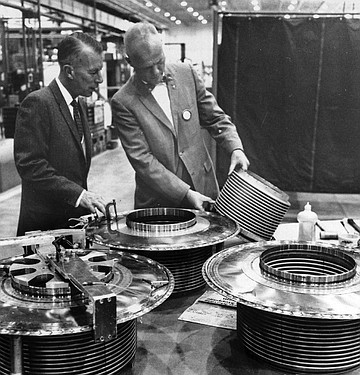
Glenn (right) handles component of Atlas at plant.
Photograph courtesy San Diego Air and Space Museum Archives
The story has taken on the trappings of a legend. National Geographic fictionalized an episode titled “Kona Kai Seance” around Glenn’s media intervention for its 2020 Disney+ series adaptation of The Right Stuff. The script combined Thompson’s 2004 description of Shepard confessing to Glenn, Glenn’s 1983 depiction of his frantic phone work, and Wolfe’s 1979 portrayal of the contentious meeting. It then collapsed the action of two nights into a twelve-hour span, and in doing so, dramatically altered the facts: Shepard coming late at night to Glenn’s room, telling Glenn that he got caught having sex in Tijuana by a reporter/photographer from the “San Diego Herald,” and that a story would be running in the morning; Glenn immediately calling Powers to get the publisher’s phone number, Glenn rousing the publisher out of bed and begging for the expose to be killed; Glenn checking the morning paper and then calling for the seance; and Shepard turning on Glenn for having told Powers what happened, asserting that Glenn just wanted to be seen as the program’s savior.
Glenn would probably have approved of at least part of the wholesale literary license taken by the series’ scriptwriters. In September 1983, he had disingenuously complained in a New York Times interview that “the whole background of the [seance] wasn’t in Wolfe’s book and I suppose won’t be in the [upcoming] movie adaptation.” Glenn protested that “it wasn’t that I was a Presbyterian prude trying to lecture people on their moral life.” Rather, he was worried about the group’s image “if somebody got caught in the wrong boudoir.” But at the time he talked to the Times reporter, he had never disclosed the Tijuana/newspaper backstory necessary to put the seance into the context of a scandal barely dodged. It was not until the following month, October 1983, that the backstory first became known, with publication of Van Riper’s biography, released in the same week as Philip Kaufman’s three-hour movie adaptation of The Right Stuff. (In the film, the seance confrontation was moved to the group’s training room in Florida to order to fit script alterations to Wolfe’s book.)
Glenn came to believe that his forestalling a squalid media humiliation of both Shepard and the program fell into the category of “no good deed goes unpunished.” Space officials in early 1961 asked astronauts to rank their top three choices — other than themselves — as best qualified to make the first flights. It was a chance, as Glenn put it, for the majority of his colleagues to take revenge on his clean-cut image. “After my [seance] comments about everybody’s needing to keep their pants zipped…my subsequent chances of being first in space were slim if a peer vote was even a small factor in the decision.”
Yet his failure to be selected for the first launch ironically worked in favor of Glenn’s legacy, as Shepard biographer Thompson has observed. Glenn’s five-hour flight in 1962 as the first American to orbit the Earth (three revolutions) became the public’s lodestone, regarded as the nation’s real initial space achievement, and certainly eclipsing Shepard’s 15-minute suborbital ride in 1961 to measure launch and re-entry performance. It also jump-started his subsequent quarter-century career as a U.S. Senator from Ohio.
Surprisingly, despite almost four decades’ worth of books published with Glenn’s boast of squelching the Shepard escapade, no story — in San Diego or nationally — was ever printed investigating what reporter and what paper might have conspired with him. Van Riper, a New York Daily News political correspondent when he wrote Glenn’s biography, recalled no raised eyebrows during his book tour, despite the dust jacket tease of “Glenn smothering a scandal that could have wrecked the space program.”
Your correspondent is himself a San Diego native and veteran journalist, but even I had never heard of the incident before picking up Shesol’s book late last year. But that book triggered a dim childhood memory: my father mentioning something about spacemen staying at the Kona Kai and that one had gotten into some kind of trouble. Our family played tennis there, and my father was friendly with the club’s teaching pro. He was close with numerous local newsmen. However, the import of what he said registered little, if at all, with his eight-year-old son, even one who was already a newspaper junkie.
Now, after researching Glenn’s telling and retelling, I find several of his details implausible — a consequence, perhaps, of wee-hours grogginess that led him to misinterpret some of the information from Powers. Or perhaps of memory lapses over time. Or perhaps of deliberate fuzziness or misdirection designed to protect various individuals.
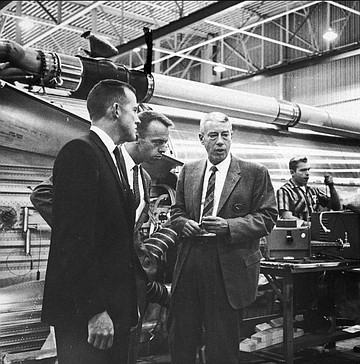
Shepard (middle individual) leans in to hear Convair executive at Atlas plant.
Photograph courtesy San Diego Air and Space Museum Archives
While he was coy for the rest of his life in saying only that a “West Coast” paper had planned to run the Shepard story, Glenn could have done his early-morning check only in the two sold at the Kona Kai: the morning San Diego Union and its afternoon sister paper, The Evening Tribune, both available from a single coin vending box outside the lobby. There was at that time no newsstand with out-of-town papers. Both local papers had assigned reporters all week to cover the astronauts in San Diego to the extent that Powers would permit, given the Life arrangement.
The Los Angeles Times had written a single article on the group during their earlier stay in L.A. and had sent no reporter to San Diego — although it maintained a stringer, Harold Keen, editorial director for Channel 8. Also, the Times offered only an early edition, printed at 7 pm the previous night, for sale at major newsstands and for limited home delivery. The nearest stand to the Kona Kai that carried the Times was a 1.5 mile-drive away: Harbor Liquor on Rosecrans Street. The Los Angeles Examiner and other West Coast dailies did not cover the astronauts in L.A. or San Diego with their own reporters, instead using one or two wire-service stories. Based on Glenn’s account, the paper in play had to be the Union or Tribune.
Then there are the timeline incongruities. Glenn said that he reached a reporter, photographer, editor and ultimately the publisher sometime after 2 am to get the story killed from the morning paper. It could not have happened that way. By that hour, before Glenn called anybody, the Union’s first street edition would have been hawked downtown for hours, and both its early county home and late city home editions would have been printed, bundled, and loaded aboard delivery trucks to carriers. The street final edition would be almost off the presses, if not already completed. Were Glenn’s tale literally true, the Union would have had to recall and destroy nearly its entire press run and print 86,000-plus substitute copies, delaying distribution for hours. Such a happenstance would have become news nationwide, a colossal embarrassment impossible to suppress. Moreover, the two major wire services, both housed inside the Union-Tribune building downtown, would already have received and read the home editions, rewritten the Tijuana bombshell to credit the Union, and sent it out worldwide.
But, as Van Riper, Taylor, and Shesol all insisted to me, something did happen with Glenn vis-a-vis a newspaper. It would contravene everything that is known about Glenn’s character for him to have fictionalized an incident. So what could have taken place? I can draw up three possible scenarios:
So Powers got a heads-up call, sulked over the potentially awful publicity and even his possible removal, and then, after several hours, got in touch with a groggy Glenn. Glenn misconstrued what Powers had told him and, erroneously believing publication to be imminent, took the bull by the horns. He called around to any contacts Powers had, and finally reached or was bumped up to publisher James Copley, given the story’s sensitivity. It’s easy to imagine Copley, a right-wing stalwart and ardent military admirer, being readily convinced by the God-and-country/anti-communist plea from Glenn, the straight-laced Marine pilot hero, and promising the story would be killed. And so it was — never getting onto a press, perhaps never even completed by a reporter. Glenn, who was not conversant with newspaper production, may have honestly believed he had gotten it removed from that morning’s edition he grabbed at the Kona Kai. (Ironically, the top news that week was Soviet Premier Nikita Khrushchev touring Los Angeles and San Francisco as part of the first-ever visit to the United States by a Soviet leader, following an invitation from President Dwight Eisenhower.)
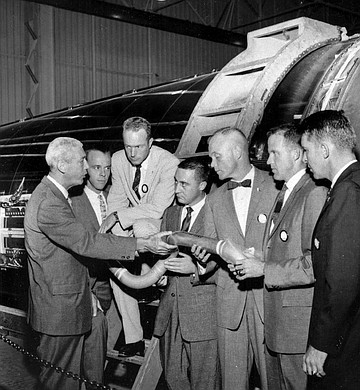
Astronauts at Convair-Aeronautics plant.
Photograph courtesy San Diego Air and Space Museum Archives
However, the Union’s stories that week were written by Peter Kaye, at the time a bright, feisty young reporter who subsequently worked for Richard Nixon, Pete Wilson, Gerald Ford, and PBS, and then, decades later, rejoined the Union as Associate Editor. Kaye, in his 2009 memoir Contrarian, mentioned the coverage in a single paragraph. The title he chose for the autobiography aptly reflected his personality, and presumably, he would have eagerly relived his spiked exclusive concerning Shepard, had there been one. The book includes copious anecdotes telling his version of incidents and individuals over a half-century that affected his career.
Regarding the astronauts, Kaye wrote merely that decades later, he met Glenn, who laughingly recalled Convair’s reassurances regarding the Atlas even as the rocket kept blowing up in tests. It’s always possible there was another reporter involved, but the Union in 1959, with its dour layout and risk-averse management, was anything but a crusading paper with a “gotcha” news reputation or titillating story mix. It strains credibility to imagine the Union assigning a reporter and photographer to tail Shepard, especially into Mexico, where a news team could end up as part of an embarrassing international incident.
But this scenario seemingly fizzles as well, because the reporter writing the Tribune stories during that week was Lew Scarr, who told me last month that he had never even heard any part of the events until I called him. Scarr, whose stylish writing graced the Tribune and later the Union for decades, thought that it was inconceivable he would be unaware of a fellow reporter being directed to stalk Shepard. He said further that Kaye, with whom he shared nearly 60 years of close friendship, starting before they joined the competing Copley papers, never broached the topic of their coverage of the astronauts. Scarr is the only known journalist associated with that week’s coverage who is still alive. He declined to speculate on what he thought might have taken place, offering simply, “That was a long time ago.”
So Morgan called Powers in the evening to give him a heads-up, perhaps telling him there were pictures as proof of the incident, not saying that they would be used (the column never included photos) or even that Shepard would be specifically identified. Nevertheless, Powers and Glenn assumed the worst. Morgan for years listed himself in the phone directory, so Glenn reached him quickly in the early hours (or perhaps Morgan had given his number to Powers). Morgan also had publisher Copley’s number at hand for Glenn, as he was the company’s most prominent news personality and occasionally socialized with the publisher. There was plenty of time to kill the item out of Morgan’s column, no matter how cleverly it might be worded.
Further, this scenario could shed light on a curiously constructed Morgan column that ran at the end of the Kona Kai week, in which he recounted his sit-down the day before with Powers and Shepard to talk about privacy boundaries in covering public figures like the astronauts. Morgan seemed sympathetic on the subject of the group’s lack of privacy as space pioneers, but then pressed in hard after Powers interceded to prevent Shepard from answering on the record even a simple question about life “in a goldfish bowl.” Morgan persevered: “I suggested that it is not within the province of federal security to censor free and casual speech on the grounds that a press conference has not been convened.” Shepard overrode Powers at that point, and proffered to Morgan that “if we are going to err in the matter of news, I think it is our duty to say too much rather than too little. We all work for the taxpayer.” Morgan then followed up by writing, “The astronauts battle in great good humor for rare moments of the privacy they have bartered away.”
For the few familiar with events earlier in the week, Shepard’s comments would have come across as laughable and stunningly hypocritical, and Morgan’s elliptical remark as incredibly strained, if not incredulous, given that it would have been his boss who had acceded to Glenn’s plea to scrap a huge scoop. Morgan was perhaps trying to put everyone in the know on notice that while they may have censored him, he was no patsy to be gaslighted. Yet this Morgan scenario, however plausible, presupposes that Glenn, for whatever reasons, garbled a significant number of details in his recollection. Morgan’s papers, housed at UC San Diego, contain no references to the 1959 visit other than copies of that year’s columns.
Dead men tell no tales. Unless an account somehow someday surfaces among the archived personal files of those who were there, we’re left with Glenn’s incomplete and unsatisfactory description. The conspiracy between a San Diego newspaper and Glenn the future American hero may forever remain a mysterious footnote to the early days of the space race.
